Examining the Impacts of Economic, Social, and Environmental Factors on the Relationship between Urbanization and CO2 Emissions
Abstract
1. Introduction
2. Literature Review
3. Methodology
3.1. Data and Sample
3.2. The Integrated Models of Urbanization–CO2 Emissions Relationship
- Factors related to economic growth: It was highlighted that economic growth, indicated by GDP per capita and income, has important implications for the relationship between urbanization and carbon dioxide emissions [11,13,14,15,34,35,38]. Moreover, research has reported that foreign direct investment (FDI) can affect the carbon dioxide emissions in host countries by driving economic development in those areas, which causes environmental degradation [56]. For instance, FDI can significantly enlarge the volume of industrial production in the host country, leading to more energy use and carbon dioxide emission. However, it is also noted that FDI for environment-friendly businesses occurs through advanced human capital and sustainable infrastructural developments. Thus, this model included three variables, namely, GDP per capita, income, and FDI to indicate the economic growth of an area.
- Factors associated with industrial transformation: It was suggested that adjustments in industrial structure provide great opportunities for emissions reductions during the urbanization process, as the energy use in the primary industry is more intense than that in the tertiary industry [49,52]. In this model, industrial transformation was included to reflect economic development.
- Factors regarding technological change: Technology is one of the main drivers of economic development. It leads to the optimization of the industrial structure and introduces new products or processes that are beneficial for environmental protection and emissions reductions, for example, renewable energy use [51], higher labor productivity [57], energy-saving buildings, and central heating systems that can improve the energy-use efficiency in urban areas [58]. The extent of technological change is indicated by both the technological input (measured by R&D spending) and technological output (measured by the number of patents) in this model.
- Factors concerning public services: Improvement in public services may not have direct effects on carbon dioxide emissions, but they are closely related to the transformation of the energy consumption patterns of urban residents. For instance, a higher awareness of the negative effect of carbon emissions on residents’ health will prompt the local government to undertake more emissions reduction measures [59]. In this model, the factors education and healthcare were adopted to indicate the social wellbeing of an area.
- Factors associated with cultural development: Urban dwellers may change their energy consumption pattern, as they will likely have a higher awareness of the importance of energy-saving measures and thus favor green products [60]. Therefore, the variable culture was included in the model.
- Factors related to demographic transition: It was found that urbanization significantly drives carbon dioxide emissions when the effects of aging and shrinking household sizes increase residential energy consumption [53]. This model included the factors of family size and senior citizens to track the demographic transition of a region.
- Factors related to urban construction: The expansion of urban areas is accompanied by the increasing construction of civic buildings and public infrastructure, which generates more carbon emissions when a large amount of infrastructure and residential buildings are under construction [58]. Later, the shift in transport behavior as a result of building public infrastructure provides opportunities for carbon emissions reductions during the urbanization process in the long term [28,54,55,61,62]. Therefore, this model considered the factors of infrastructure and transportation, which may influence carbon dioxide emissions in the urbanization process.
- Factor concerning natural environment: Research on greenhouse gases suggests that the quality of the ecological environment in urban areas, such as urban land, may have a significant impact on carbon dioxide emissions [63,64,65,66,67]. In addition, the area of natural reserves can reduce carbon dioxide emissions in the expansion process [64]. Thus, this model includes the factor natural reserves, which indicates the percentage of natural reserves in a city.
- Factors regarding disposal of industrial wastes: Disposal of industrial wastes may have specific implications for the relationship between urbanization and carbon dioxide emissions. For example, some researchers found that the disposal of multiple forms of solid waste also results in increasing carbon dioxide emissions [63]. Overall, waste treatment is indicated by the generation of wastewater, waste gas, and solid wastes within a city.
4. Results
5. Discussion and Conclusions
Author Contributions
Funding
Institutional Review Board Statement
Informed Consent Statement
Data Availability Statement
Acknowledgments
Conflicts of Interest
References
- Li, K.; Lin, B. Impacts of Urbanization and Industrialization on Energy Consumption CO2 Emissions: Does the Level of Development Matter? Renew. Sustain. Energy Rev. 2015, 52, 1107–1122. [Google Scholar] [CrossRef]
- Wang, Y.; Zhang, C.; Lu, A.; Li, L.; He, Y.; ToJo, J.; Zhu, X. A disaggregated analysis of the environmental Kuznets curve for industrial CO2 emissions in China. Appl. Energy 2017, 190, 172–180. [Google Scholar] [CrossRef]
- Wang, S.; Liu, X.; Zhou, C.; Hu, J.; Ou, J. Examining the Impacts of Socioeconomic Factors, Urban Form, and Transportation Networks on CO2 Emissions in China’s Megacities. Appl. Energy 2017, 185, 189–200. [Google Scholar] [CrossRef]
- Zhang, N.; Yu, K.; Chen, Z. How does urbanization affect carbon dioxide emissions? A cross-country panel data analysis. Energy Policy 2017, 107, 678–687. [Google Scholar] [CrossRef]
- Zhang, W.; Xu, H. Effects of land urbanization and land finance on carbon emissions: A panel data analysis for Chinese provinces. Land Use Policy 2017, 63, 493–500. [Google Scholar] [CrossRef]
- Wang, S.; Ma, Y. Influencing factors and regional discrepancies of the efficiency of carbon dioxide emissions in Jiangsu, China. Ecol. Indic. 2018, 90, 460–468. [Google Scholar] [CrossRef]
- Li, J.; Huang, X.; Kwan, M.P.; Yang, H.; Chuai, X. The effect of urbanization on carbon dioxide emissions efficiency in the Yangtze River Delta, China. J. Clean. Prod. 2018, 188, 38–48. [Google Scholar] [CrossRef]
- Kaika, D.; Zervas, E. The Environmental Kuznets Curve (KEC) theory-Part A: Concept, causes and the CO2 emissions case. Energy Policy 2013, 62, 1392–1402. [Google Scholar] [CrossRef]
- Li, T.; Wang, Y.; Zhao, D. Environmental Kuznets Curve in China: New evidence from dynamic panel analysis. Energy Policy 2016, 91, 138–147. [Google Scholar] [CrossRef]
- Sadik-Zada, E.R.; Ferrari, M. Environmental policy stringency, technical progress and pollution haven hypothesis. Sustainability 2020, 12, 3880. [Google Scholar] [CrossRef]
- Sadik-Zada, E.R.; Gatto, A. The puzzle of greenhouse gas footprints of oil abundance. Socio-Econ. Plan. Sci. 2021, 75, 100936. [Google Scholar] [CrossRef]
- Chikaraishi, M.; Fujiwara, A.; Kaneko, S.; Poumanyvong, P.; Komatsu, S.; Kalugin, A. The moderating effects of urbanization on carbon dioxide emissions: A latent class modeling approach. Technol. Forecast. Soc. Chang. 2015, 90, 302–317. [Google Scholar] [CrossRef]
- Haseeb, A.; Xia, E.; Baloch, M.A.; Abbas, K. Financial Development, Globalization, and CO2 Emission in the Presence of EKC: Evidence from BRICS Countries. Environ. Sci. Pollut. Res. 2018, 25, 31283–31296. [Google Scholar] [CrossRef]
- Haouraji, C.; Mounir, B.; Mounir, I.; Farchi, A. Exploring the Relationship between Residential CO2 Emissions, Urbanization, Economic Growth, and Residential Energy Consumption: Evidence from the North Africa Region. Energies 2021, 14, 5849. [Google Scholar] [CrossRef]
- Kasman, A.; Duman, Y.S. CO2 emissions, economic growth, energy consumption, trade and urbanization in new EU member and candidate countries: A panel data analysis. Econ. Model. 2015, 44, 97–103. [Google Scholar] [CrossRef]
- Sun, W.; Huang, C. How does urbanization affect carbon emission efficiency? Evidence from China. J. Clean. Prod. 2020, 272, 122828. [Google Scholar] [CrossRef]
- Liu, B.; Tian, C.; Li, Y.; Song, H.; Ma, Z. Research on the effects of urbanization on carbon emissions efficiency of urban agglomerations in China. J. Clean. Prod. 2018, 197, 1374–1381. [Google Scholar] [CrossRef]
- Zhou, C.; Wang, S.; Wang, J. Examining the influences of urbanization on carbon dioxide emissions in the Yangtze River Delta, China: Kuznets curve relationship. Sci. Total Environ. 2019, 675, 472–482. [Google Scholar] [CrossRef]
- Zhou, Y.; Chen, M.; Tang, Z.; Mei, Z. Urbanization, land use change, and carbon emissions: Quantitative assessments for city-level carbon emissions in Beijing-Tianjin-Hebei region. Sustain. Cities Soc. 2021, 66, 102701. [Google Scholar] [CrossRef]
- Yao, F.; Zhu, H.; Wang, M. The Impact of Multiple Dimensions of Urbanization on CO2 Emissions: A Spatial and Threshold Analysis of Panel Data on China’s Prefecture-Level Cities. Sustain. Cities Soc. 2021, 73, 103113. [Google Scholar] [CrossRef]
- Ren, F.; Yu, X. Coupling analysis of urbanization and ecological total factor energy efficiency—A case study from Hebei province in China. Sustain. Cities Soc. 2021, 74, 103183. [Google Scholar] [CrossRef]
- Lehmann, S. Can rapid urbanisation ever lead to low carbon cities? The case of Shanghai in comparison to Potsdamer Platz Berlin. Sustain. Cities Soc. 2012, 3, 1–12. [Google Scholar] [CrossRef]
- Du, L.; Chu, W.; Cai, S. Economic development and carbon dioxide emissions in China: Provincial panel data analysis. China Econ. Rev. 2012, 23, 371–384. [Google Scholar] [CrossRef]
- Sun, J.; Shi, J.; Shen, B.; Li, S.; Wang, Y. Nexus among Energy Consumption, Economic Growth, Urbanization and Carbon Emissions: Heterogeneous Panel Evidence Considering China’s Regional Differences. Sustainability 2018, 10, 2383. [Google Scholar] [CrossRef]
- Sun, X.; Li, J.; Qiao, H.; Zhang, B. Energy implications of China’s regional development: New insights from multi-regional input-output analysis. Appl. Energy 2017, 196, 118–131. [Google Scholar] [CrossRef]
- Wang, Y.; Wang, Y.; Zhou, J.; Zhu, X.; Lu, G. Energy Consumption and Economic Growth in China: Amultivariate Causality Test. Energy Policy 2011, 39, 4399–4406. [Google Scholar] [CrossRef]
- Yan, H. Provincial energy intensity in China: The role of urbanization. Energy Policy 2015, 86, 635–650. [Google Scholar] [CrossRef]
- Poumanyvong, P.; Kaneko, S. Does Urbanization Lead to Less Energy Use and Lower CO2 Emissions? Across-Country Analysis. Ecol. Econ. 2010, 70, 1344–1353. [Google Scholar] [CrossRef]
- Al-Mulali, U.; Sab, C.N.B.C.; Fereidouni, H.G. Exploring the bi-directional long run relationship between urbanization, energy consumption, and carbon dioxide emission. Energy 2012, 46, 156–167. [Google Scholar] [CrossRef]
- Jorgenson, A.K.; Auerbach, D.; Clark, B. The (De-) carbonization of urbanization, 1960–2010. Clim. Chang. 2014, 127, 561–575. [Google Scholar] [CrossRef]
- Barido, D.P.D.L.; Marshall, J.D. Relationship between Urbanization and CO2 Emissions Depends on Income Level and Policy. Environ. Sci. Technol. 2014, 48, 3632–3639. [Google Scholar] [CrossRef]
- Adams, S.; Nsiah, C. Reducing Carbon Dioxide Emissions; Does Renewable Energy Matter? Sci. Total Environ. 2019, 693, 133288. [Google Scholar] [CrossRef]
- Al-Mulali, U.; Fereidouni, H.G.; Lee, Y.; Sab, C.N.B.C. Exploring the relationship between urbanization, energy consumption, and CO2 emission in MENA countries. Renew. Sustain. Energy Rev. 2013, 23, 107–112. [Google Scholar] [CrossRef]
- Raggad, B. Carbon dioxide emissions, economic growth, energy use, and urbanization in Saudi Arabia: Evidence from the ARDL approach and impulse saturation break tests. Environ. Sci. Pollut. Res. 2018, 25, 14882–14898. [Google Scholar] [CrossRef]
- Shahbaz, M.; Sbia, R.; Hamdi, H.; Ozturk, I. Economic growth, electricity consumption, urbanization and environmental degradation relationship in United Arab Emirates. Ecol. Indic. 2014, 45, 622–631. [Google Scholar] [CrossRef]
- Martinez-Zarzoso, I.; Maruotti, A. The impact of urbanization on CO2 emissions: Evidence from developing countries. Ecol. Econ. 2011, 70, 1344–1353. [Google Scholar] [CrossRef]
- Wang, Y.; Li, L.; Kubota, J.; Han, R.; Zhu, X.; Lu, G. Does urbanization lead to more carbon emission? Evidence from a panel of BRICS countries. Appl. Energy 2016, 168, 375–380. [Google Scholar] [CrossRef]
- Zhu, H.; Xia, H.; Guo, Y.; Peng, C. The heterogeneous effects of urbanization and income inequality on CO2 emissions in BRICS economies: Evidence from panel quantile regression. Environ. Sci. Pollut. Res. 2018, 25, 17176–17193. [Google Scholar] [CrossRef]
- Hossain, M.S. Panel Estimation for CO2 Emissions, Energy Consumption, Economic Growth, Trade Openness and Urbanization of Newly Industrialized Countries. Energy Policy 2011, 39, 6991–6999. [Google Scholar] [CrossRef]
- Sadorsky, P. The effect of urbanization on CO2 emissions in emerging economies. Energy Econ. 2014, 41, 147–153. [Google Scholar] [CrossRef]
- Feng, K.; Siu, Y.L.; Guan, D.; Hubacek, K. Analyzing Drivers of Regional Carbon Dioxide Emissions for China: A Structural Decomposition Analysis. J. Ind. Ecol. 2012, 16, 600–611. [Google Scholar] [CrossRef]
- Wang, S.; Fang, C.; Guan, X.; Pang, B.; Ma, H. Urbanisation, Energy Consumption, and Carbon Dioxide Emissions in China: A Panel Data Analysis of China’s Provinces. Appl. Energy 2014, 136, 738–749. [Google Scholar] [CrossRef]
- Liu, Y.; Yan, B.; Zhou, Y. Urbanization, economic growth, and carbon dioxide emissions in China: A panel cointegration and causality analysis. J. Geogr. Sci. 2015, 26, 131–152. [Google Scholar] [CrossRef]
- Fan, J.-S.; Zhou, L. Impact of urbanization and real estate investment on carbon emissions: Evidence from China’s provincial regions. J. Clean. Prod. 2018, 209, 309–323. [Google Scholar] [CrossRef]
- Zhang, Y.; Wang, H.; Liang, S.; Xu, M.; Liu, W.; Li, S.; Zhang, R.; Nielsen, C.P.; Bi, J. Temporal and spatial variations in consumption-based carbon dioxide emissions in China. Renew. Sustain. Energy Rev. 2014, 40, 60–68. [Google Scholar] [CrossRef]
- Hao, H.; Geng, Y.; Wang, H.; Ouyang, M. Regional disparity of urban passenger transport associated GHG (greenhouse gas) emissions in China: A review. Energy 2014, 68, 783–793. [Google Scholar] [CrossRef]
- Zhou, X. Study on the Relationship between Urbanization and Carbon Dioxide Emissions in China. China Popul. Resour. Environ. 2011, 12, 875–895. [Google Scholar]
- Wang, F.; Gao, M.; Liu, J.; Qin, Y.; Wang, G.; Fan, W.; Ji, L. An Empirical Study on the Impact Path of Urbanization to Carbon Emissions in the China Yangtze River Delta Urban Agglomeration. Appl. Sci. 2019, 9, 1116. [Google Scholar] [CrossRef]
- Zhang, Y.-J.; Liu, Z.; Zhang, H.; Tan, T.-D. The impact of economic growth, industrial structure and urbanization on carbon emission intensity in China. Nat. Hazards 2014, 73, 579–595. [Google Scholar] [CrossRef]
- Liu, M.; Liu, Y. The Relationship between the Development of China’s Urbanization and Carbon Emission: An Empisical Study Based on 30 Provinces’ Data. Urban Stud. 2011, 18, 27–32. [Google Scholar]
- Zhou, X.; Zhang, J.; Li, J. Industrial structural transformation and carbon dioxide emissions in China. Energy Policy 2013, 57, 43–51. [Google Scholar] [CrossRef]
- Behera, S.R.; Dash, D.P. The effect of urbanization, energy consumption, and foreign direct investment on the carbon dioxide emission in the SSEA (South and Southeast Asian) region. Renew. Sustain. Energy Rev. 2017, 70, 96–106. [Google Scholar] [CrossRef]
- Zhu, Q.; Peng, X. The impacts of population change on carbon emissions in China during 1978–2008. Environ. Impact Assess. Rev. 2012, 36, 1–8. [Google Scholar] [CrossRef]
- Madlener, R.; Sunak, Y. Impacts of Urbanization on Urbanstructures and Energy Demand: What Can We Learn for Urban Energy Planning and Urbanization Management? Sustain. Cities Soc. 2011, 1, 45–53. [Google Scholar] [CrossRef]
- Sadorsky, P. Do Urbanization and Industrialization Affect Energy Intensity in Developing Countries? Energy Econ. 2013, 37, 52–59. [Google Scholar] [CrossRef]
- Ekeocha, D.O. Urbanization, inequality, economic development and ecological footprint: Searching for turning points and regional homogeneity in Africa. J. Clean. Prod. 2020, 291, 125244. [Google Scholar] [CrossRef]
- Krey, V.; O’Neill, B.C.; van Ruijven, B.; Chaturvedi, V.; Daioglou, V.; Eom, J.; Jiang, L.; Nagai, Y.; Pachauri, S.; Ren, X. Urban and rural energy use and carbon dioxide emissions in Asia. Energy Econ. 2012, 34, S272–S283. [Google Scholar] [CrossRef]
- Ma, B. Does urbanization affect energy intensities across provinces in China? Long-run elasticities estimation using dynamic panels with heterogeneous slopes. Energy Econ. 2015, 49, 390–401. [Google Scholar] [CrossRef]
- Dong, H.; Xue, M.; Xiao, Y.; Liu, Y. Do carbon emissions impact the health of residents? Considering China’s industrialization and urbanization. Sci. Total Environ. 2020, 758, 143688. [Google Scholar] [CrossRef]
- Zhang, C.; Lin, Y. Panel Estimation for Urbanization, Energy Consumption and CO2 Emissions: Are Gional Analysis in China. Energy Policy 2012, 49, 488–498. [Google Scholar] [CrossRef]
- Huo, T.; Cao, R.; Du, H.; Zhang, J.; Cai, W.; Liu, B. Nonlinear influence of urbanization on China’s urban residential building carbon emissions: New evidence from panel threshold model. Sci. Total Environ. 2021, 772, 145058. [Google Scholar] [CrossRef]
- Lv, Q.; Liu, H.; Yang, D.; Liu, H. Effects of Urbanization on Freight Transport Carbon Emissions in China: Common Characteristics and Regional Disparity. J. Clean. Prod. 2019, 211, 481–489. [Google Scholar] [CrossRef]
- Xin, C.; Zhang, T.; Tsai, S.-B.; Zhai, Y.-M.; Wang, J. An Empirical Study on Greenhouse Gas Emission Calculations under Different Municipal Solid Waste Management Strategies. Appl. Sci. 2020, 10, 1673. [Google Scholar] [CrossRef]
- Pawłowski, A.; Pawłowska, M.; Pawłowski, L. Mitigation of Greenhouse Gases Emissions by Management of Terrestrial Ecosystem. Ecol. Chem. Eng. 2017, 24, 213–221. [Google Scholar] [CrossRef]
- Xu, B.; Lin, B. Differences in regional emissions in China’s transport sector: Determinants and reduction strategies. Energy 2016, 95, 459–470. [Google Scholar] [CrossRef]
- Han, J.; Meng, X.; Zhou, X.; Yi, B.; Liu, M.; Xiang, W.N. A Long-Term Analysis of Urbanization Process, Landscape Change, and Carbon Sources and Sinks: A Case Study in China’s Yangtze River Delta Region. J. Clean. Prod. 2017, 141, 1040–1050. [Google Scholar] [CrossRef]
- Tao, Y.; Li, F.; Wang, R.; Zhao, D. Effects of land use and cover change on terrestrial carbon stocks in urbanized areas: A study from Changzhou, China. J. Clean. Prod. 2015, 103, 651–657. [Google Scholar] [CrossRef]
- Sadik-Zada, E.R.; Loewenstein, W. Drivers of CO2-Emissions in Fossil Fuel Abundant Settings: (Pooled) Mean Group and Nonparametric Panel Analyses. Energies 2020, 13, 3956. [Google Scholar] [CrossRef]
- Lee, J.; Robinson, P.M. Panel nonparametric regression with fixed effects. J. Econom. 2015, 188, 346–362. [Google Scholar] [CrossRef][Green Version]

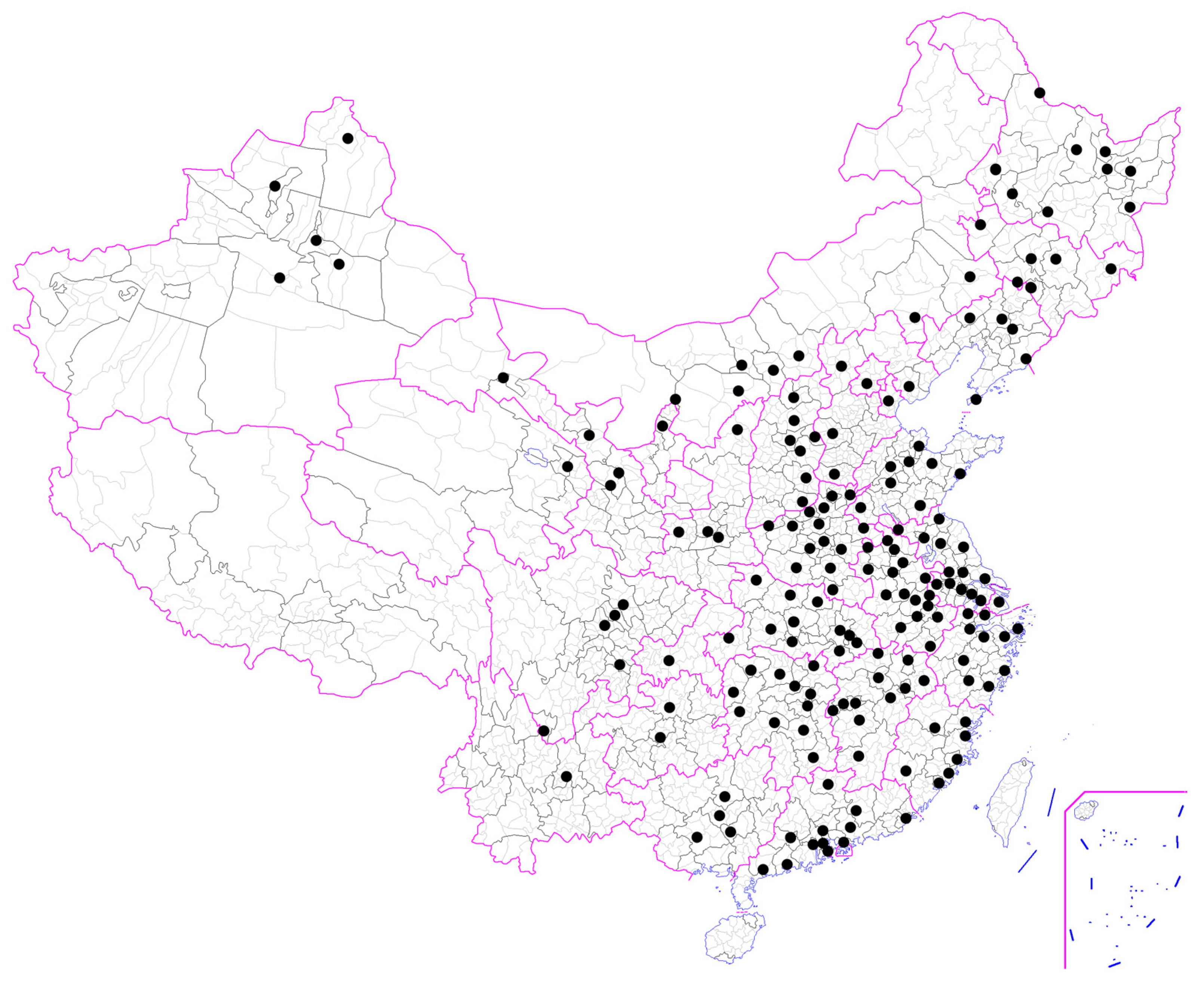
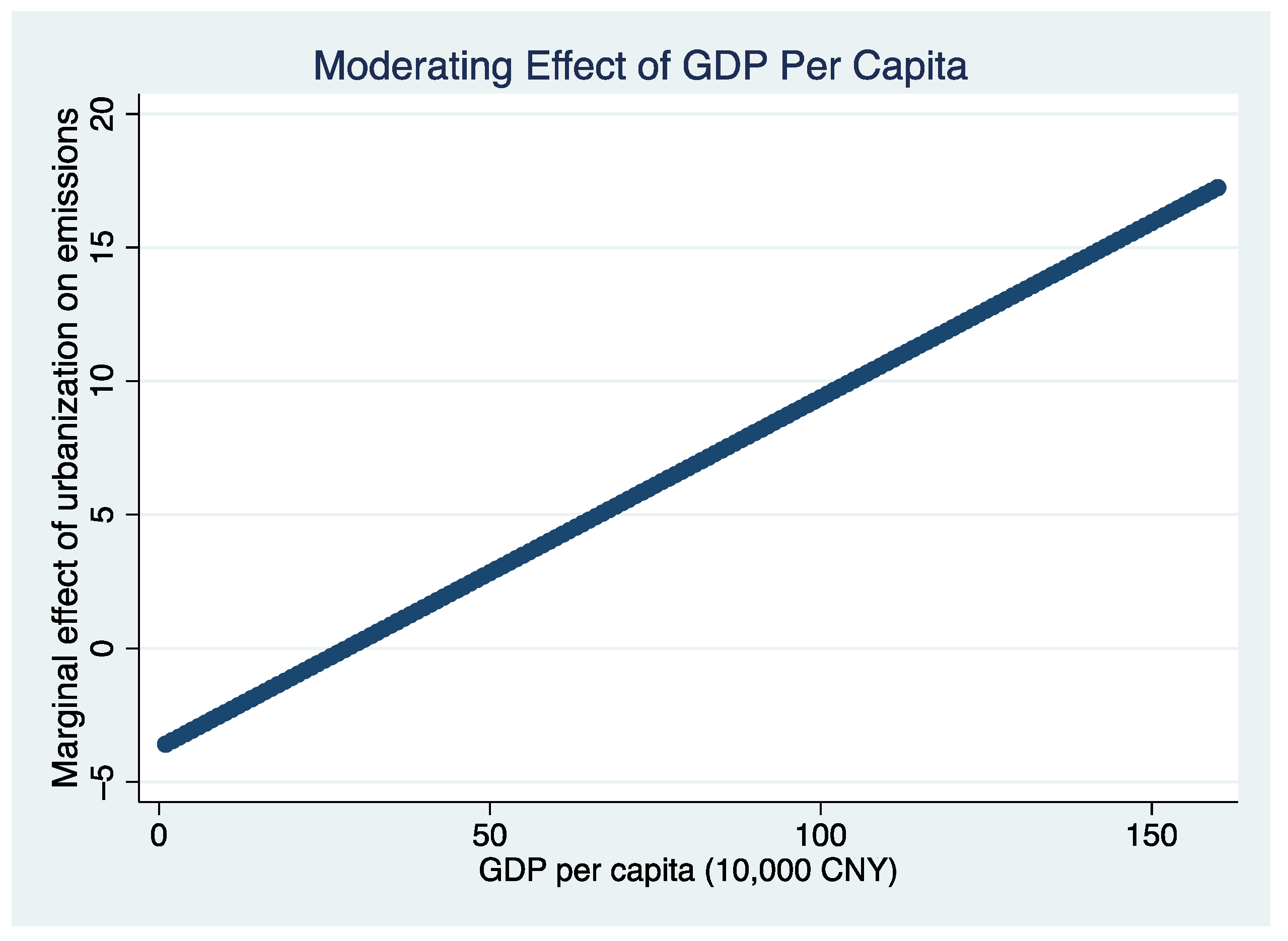
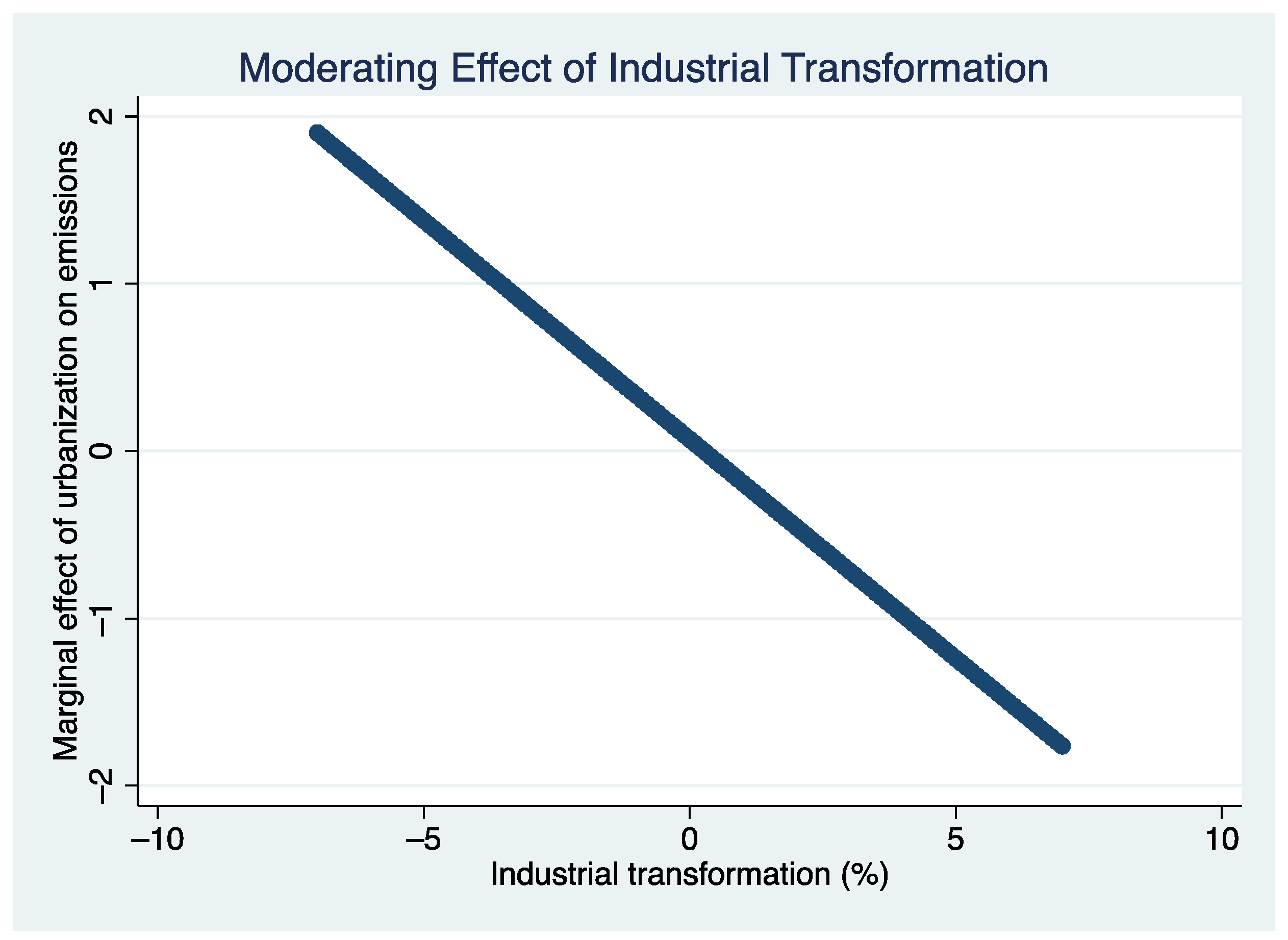
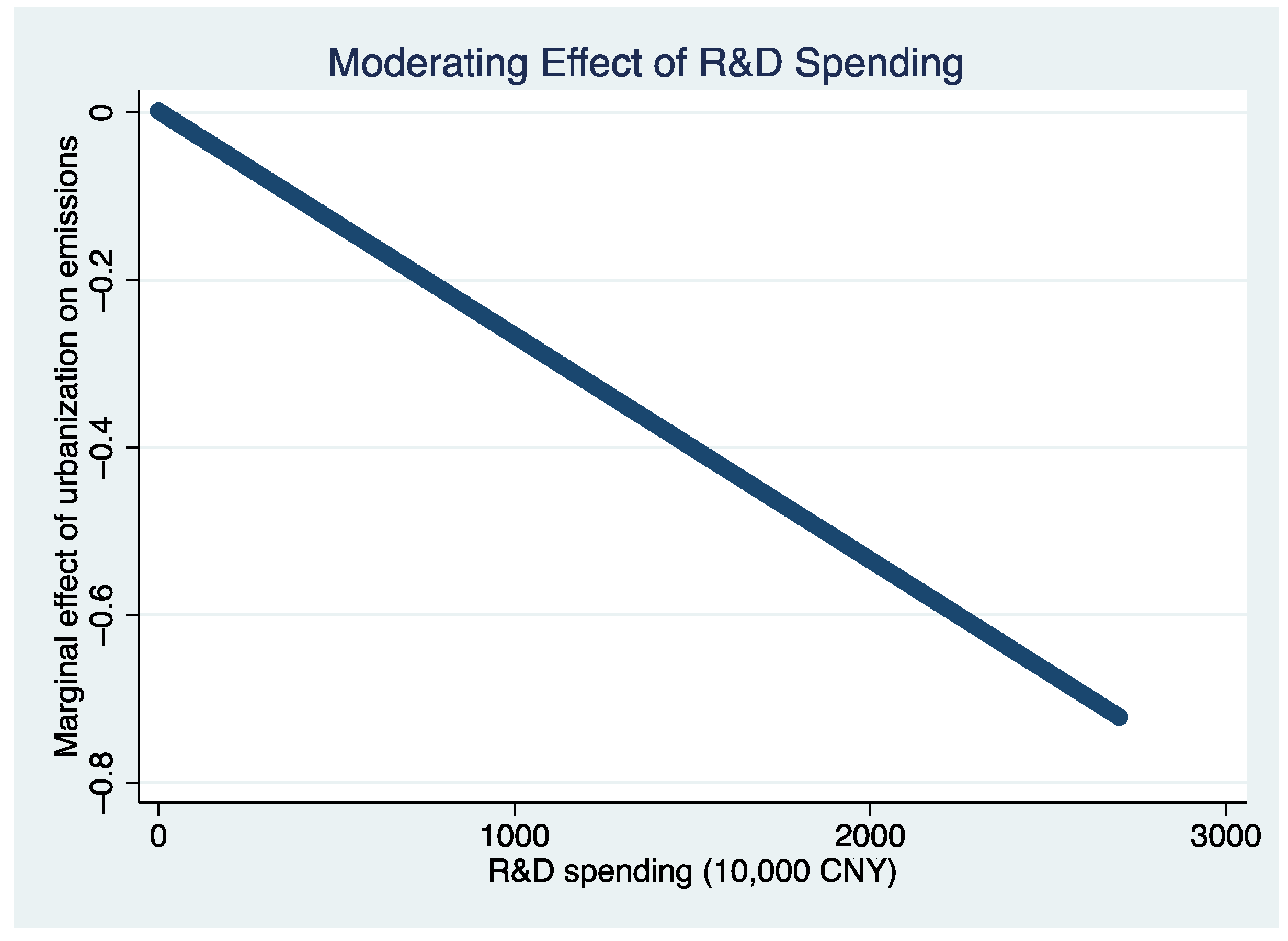
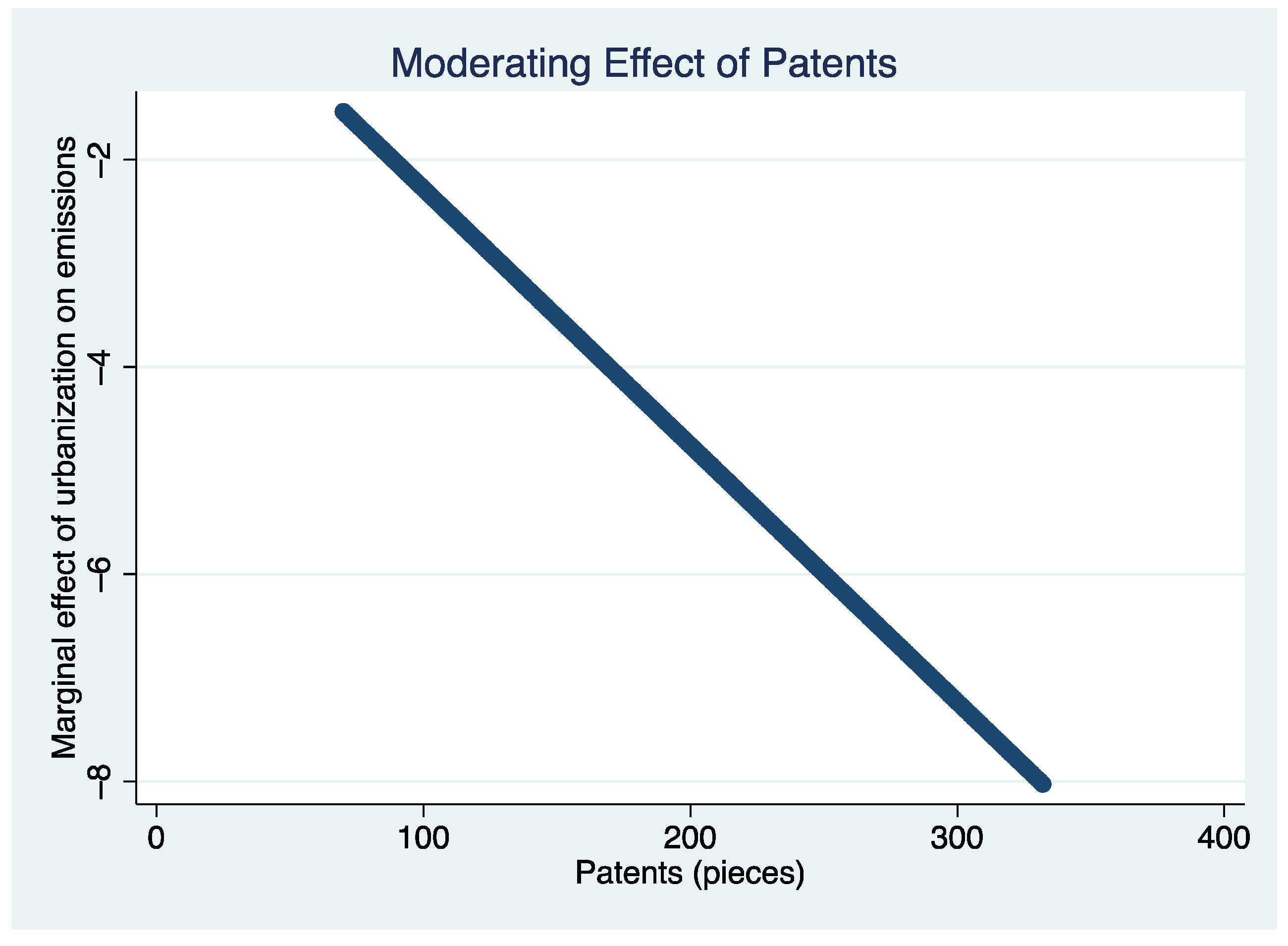
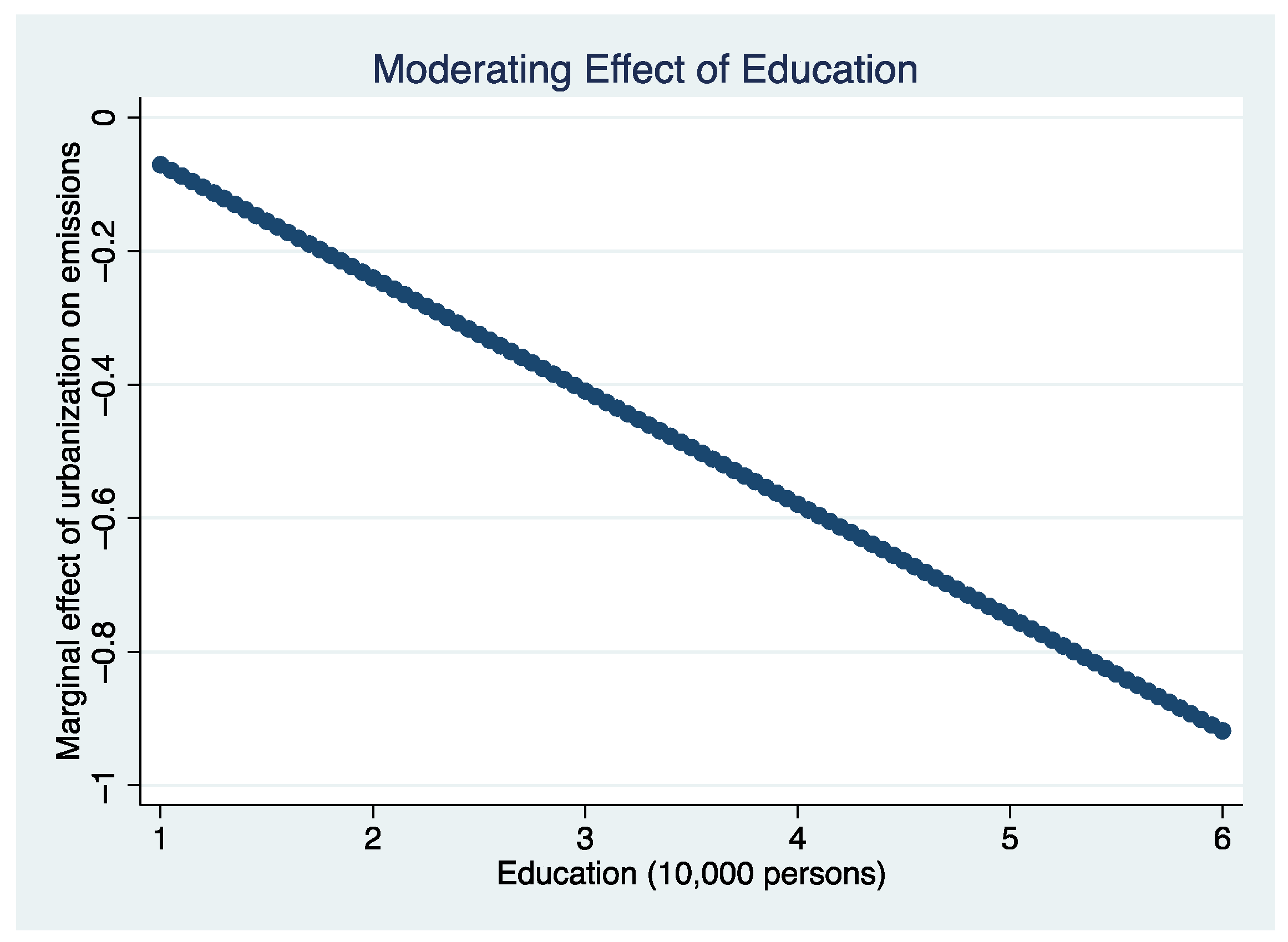
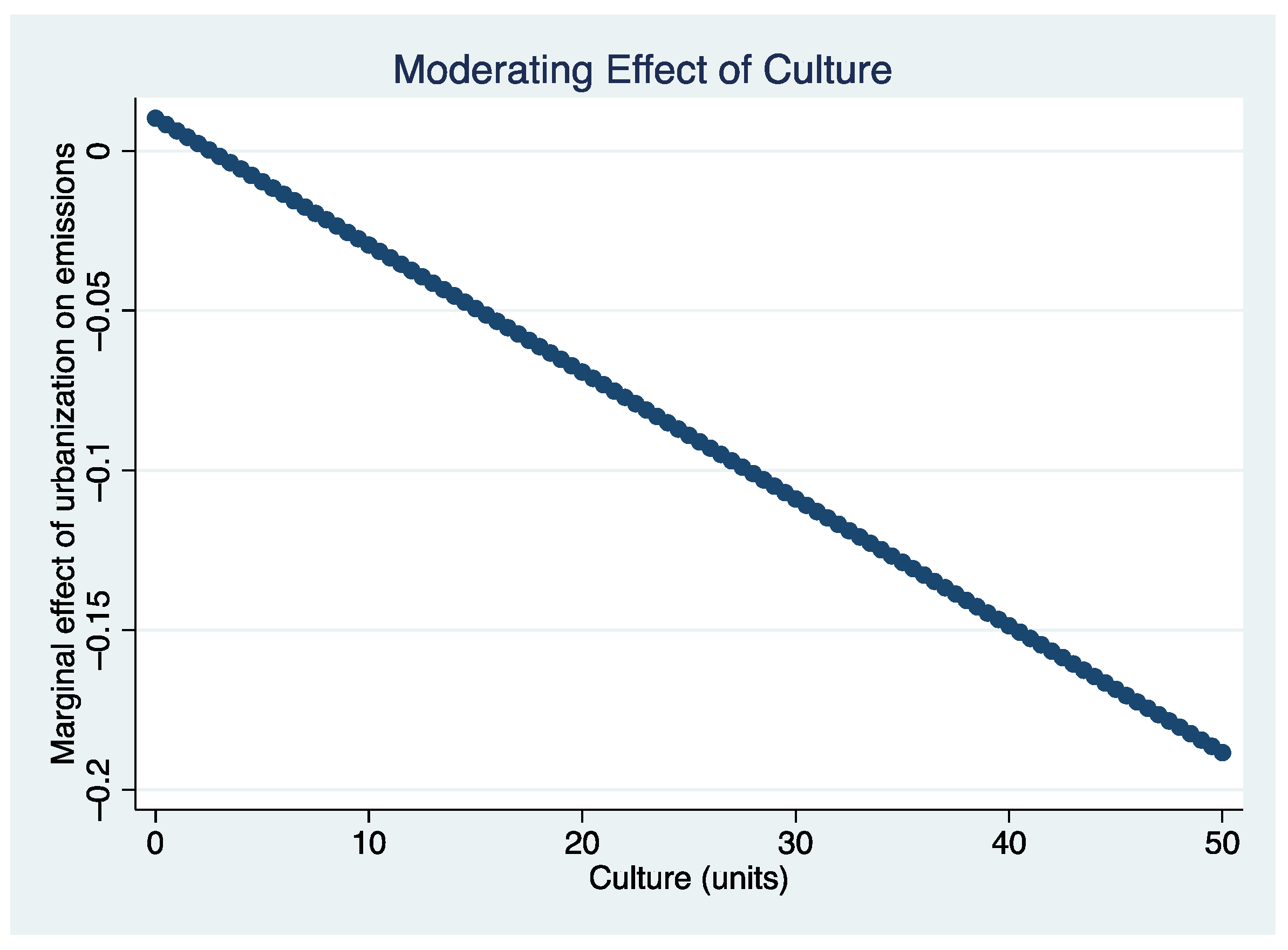
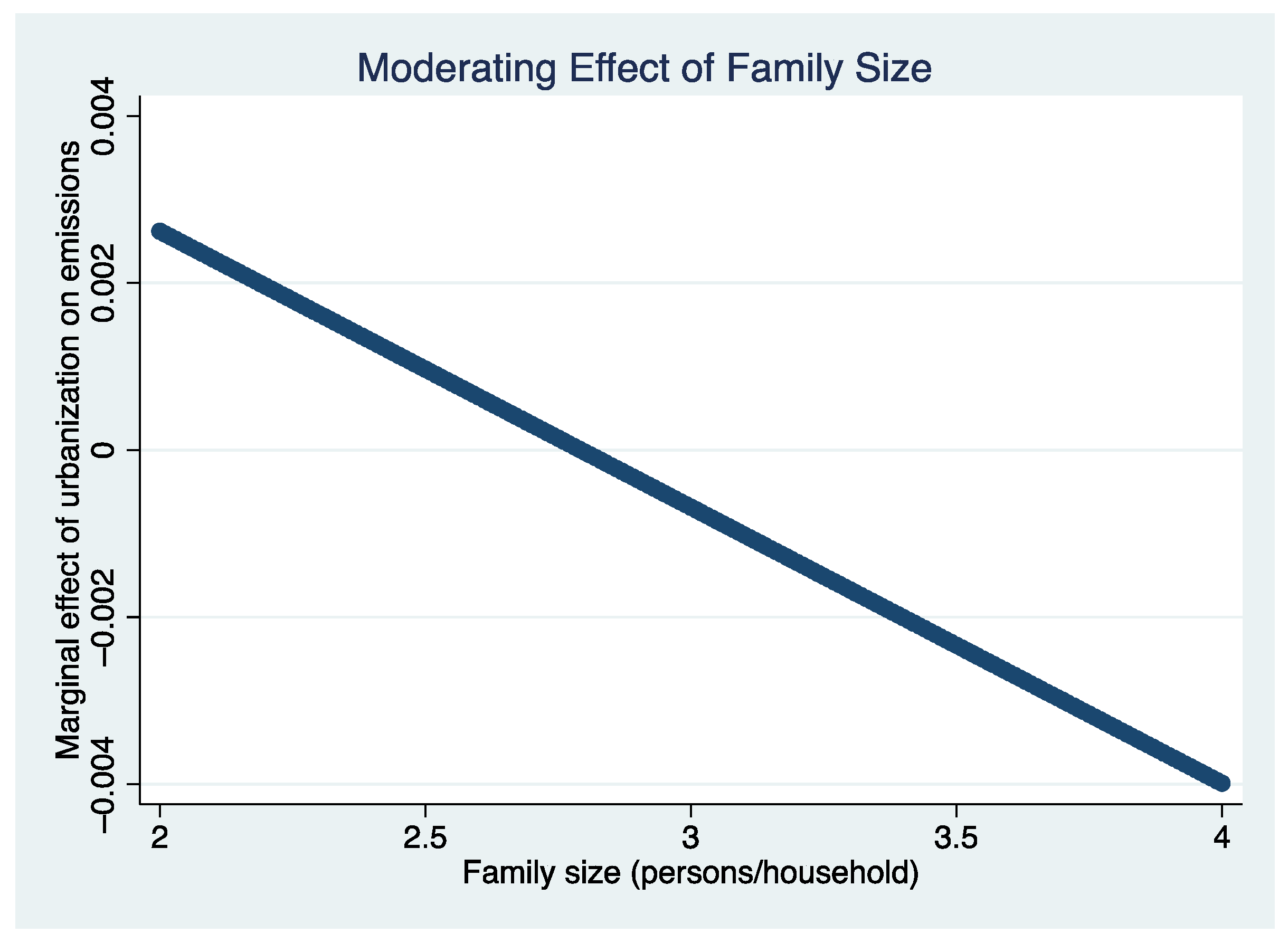
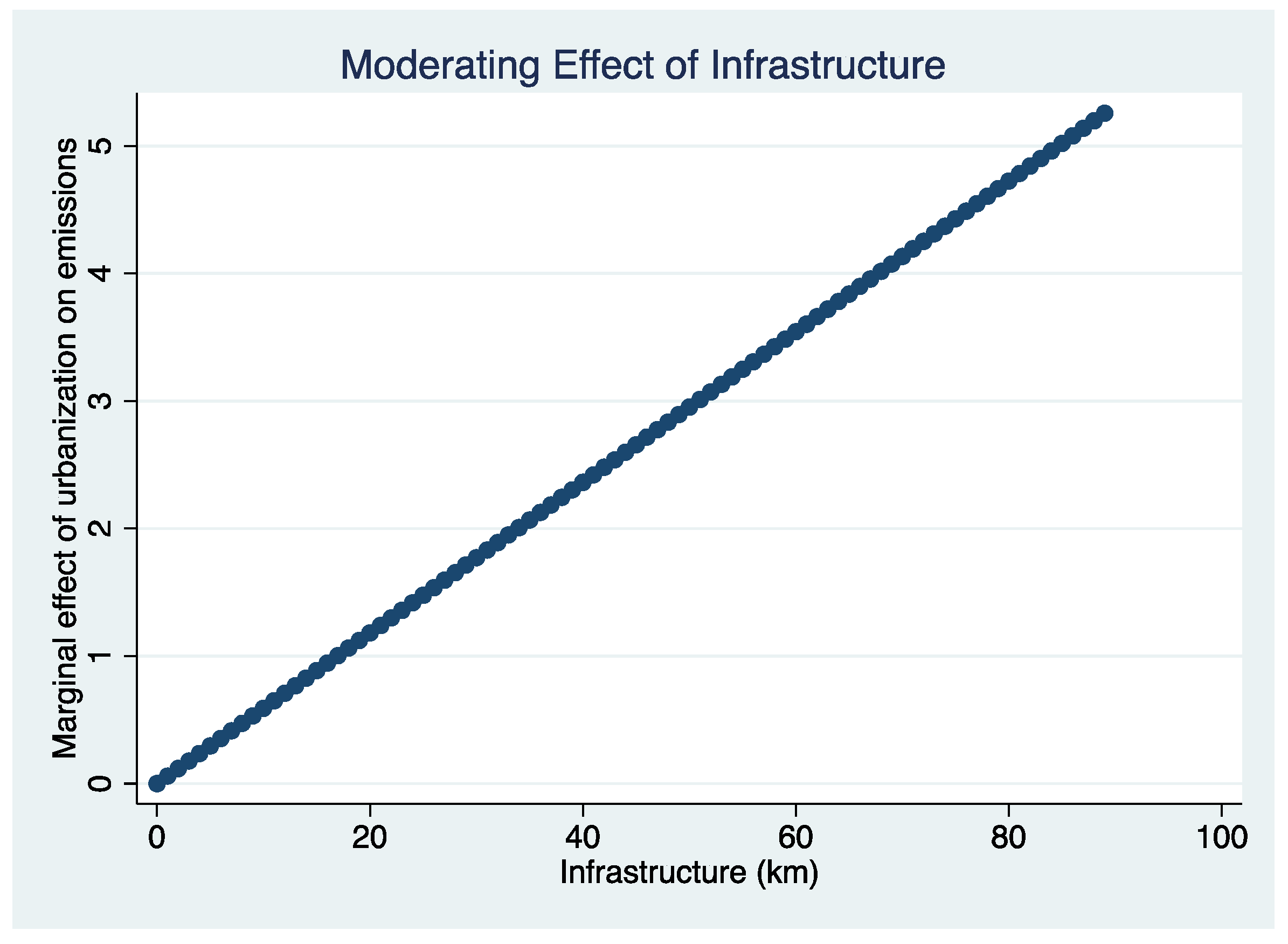

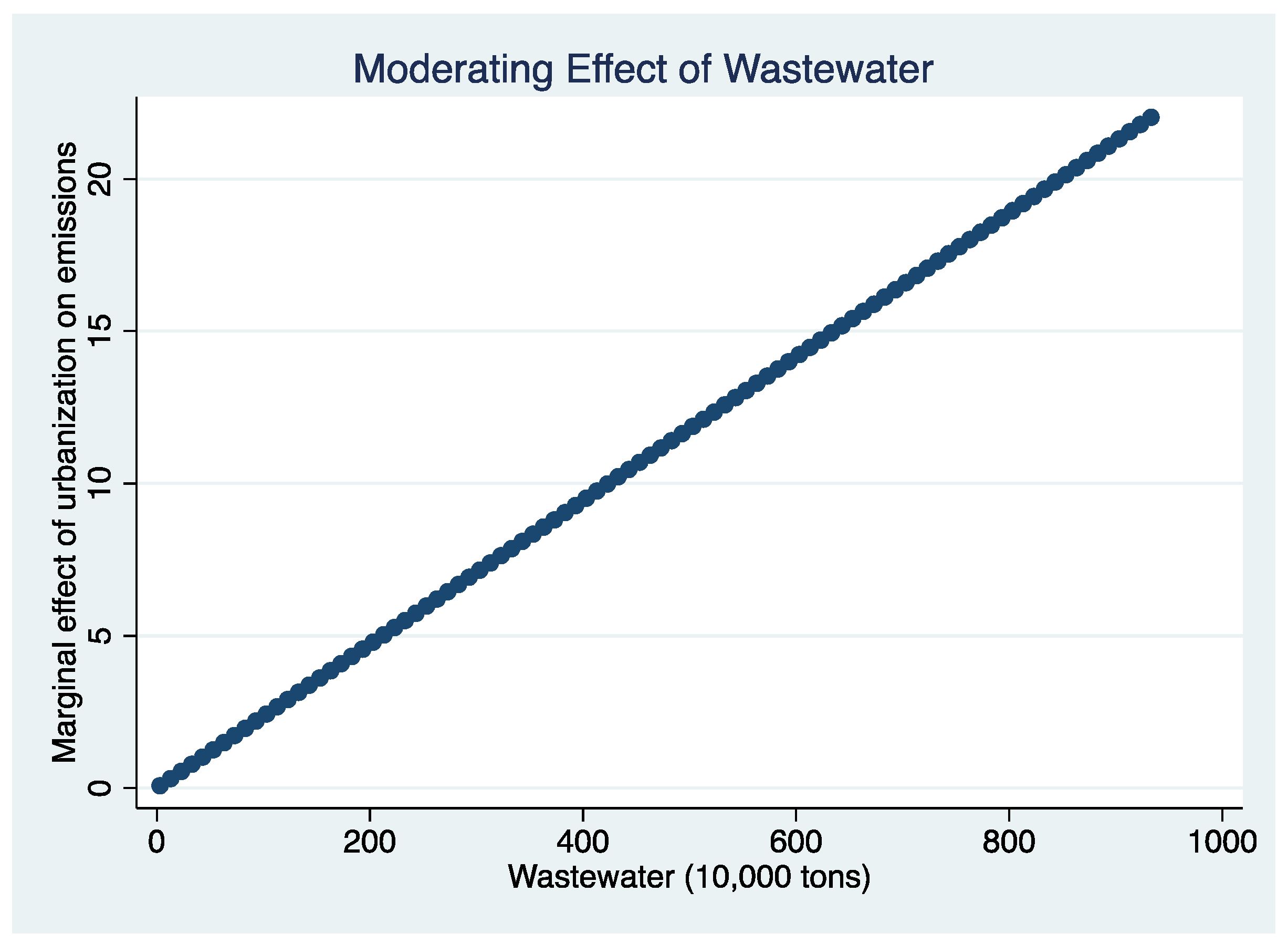
| Cluster | Variable | Measure |
|---|---|---|
| Environmental outcome | CO2 emissions | Carbon dioxide emission inventory generated by the fuel combustion of a city (Mt) |
| Urbanization | Urbanization rate | The percentage of the urban population in the overall population of a city (%) |
| Economic processes | GDP per capita | Gross domestic product per capita in a city (CNY 10,000) |
| Income | Income of urban residents (CNY 10,000) | |
| FDI | The sum of foreign direct investment of a city (USD 10,000) | |
| Industrial transformation | Increase in the share of tertiary industry in a city (%) | |
| R&D spending | The aggregate of R&D expenditure of all high-tech firms in a city (CNY 10,000) | |
| Patents | The accumulative number of patents applied for by all high-tech firms in a city (pieces) | |
| Social processes | Education | Educated population of a city (10,000 persons) |
| Healthcare | The number of employed personnel in healthcare institutions by city (10,000 persons) | |
| Culture | The number of libraries and museums of a city (units) | |
| Family size | Average family size (persons/household) | |
| Senior citizens | Population aged 65 and over (persons) | |
| Environmental processes | Infrastructure | The amount of gas supply of a city (km) |
| Transportation | The number of passengers carried by the public transportation services of a city (10,000 passengers) | |
| Natural reserves | Percentage of nature reserves in a city (%) | |
| Wastewater | Total volume of wastewater discharge (10,000 tons) | |
| Waste gas | Total volume of industrial waste gas emission (100 million m3) | |
| Solid wastes | Volume industrial solid wastes produced (10,000 tons) |
| Variable Name | Mean | S.D. | Min | Max | 1 | 2 | 3 | 4 | 5 | 6 | 7 | 8 | 9 | 10 | 11 | 12 | 13 | 14 | 15 | 16 | 17 | 18 | 19 |
|---|---|---|---|---|---|---|---|---|---|---|---|---|---|---|---|---|---|---|---|---|---|---|---|
| 1 CO2 emissions | 236 | 178 | 1 | 842 | 1.00 | ||||||||||||||||||
| 2 Urbanization rate | 51 | 15 | 23 | 89 | 0.08 | 1.00 | |||||||||||||||||
| 3 GDP per capita | 34 | 27 | 2 | 164 | 0.26 | 0.65 | 1.00 | ||||||||||||||||
| 4 Industrial transformation | 0.81 | 2.08 | −7 | 9.10 | −0.14 | 0.42 | 0.68 | 1.00 | |||||||||||||||
| 5 FDI | 539 | 668 | 1 | 3575 | 0.54 | 0.54 | 0.63 | 0.29 | 1.00 | ||||||||||||||
| 6 Income | 19 | 12 | 4 | 73 | 0.26 | 0.69 | 0.71 | 0.69 | 0.56 | 1.00 | |||||||||||||
| 7 R&D spending | 253 | 400 | 1 | 2705 | −0.49 | 0.46 | 0.52 | 0.51 | 0.79 | 0.71 | 1.00 | ||||||||||||
| 8 Patents | 22 | 44 | 70 | 332 | −0.46 | 0.41 | 0.57 | 0.33 | 0.76 | 0.60 | 0.89 | 1.00 | |||||||||||
| 9 Education | 2 | 1 | 1 | 6 | −0.03 | 0.62 | 0.58 | 0.68 | 0.34 | 0.51 | 0.42 | 0.21 | 1.00 | ||||||||||
| 10 Culture | 6 | 7 | 0 | 49 | −0.40 | 0.35 | 0.40 | 0.32 | 0.69 | 0.53 | 0.84 | 0.79 | 0.24 | 1.00 | |||||||||
| 11 Healthcare | 2 | 10 | 1 | 91 | 0.51 | −0.17 | −0.04 | −0.23 | 0.50 | 0.05 | 0.45 | 0.45 | −0.19 | 0.55 | 1.00 | ||||||||
| 12 Family size | 3 | 0 | 2 | 4 | −0.25 | −0.50 | −0.45 | −0.45 | −0.41 | −0.51 | −0.42 | −0.30 | −0.62 | −0.27 | −0.03 | 1.00 | |||||||
| 13 Senior citizens | 9 | 2 | 4 | 16 | 0.24 | 0.41 | 0.43 | 0.31 | 0.42 | 0.42 | 0.39 | 0.28 | 0.45 | 0.37 | 0.24 | −0.57 | 1.00 | ||||||
| 14 Infrastructure | 11 | 13 | 0 | 89 | 0.56 | 0.44 | 0.44 | 0.35 | 0.50 | 0.45 | 0.45 | 0.56 | 0.35 | 0.59 | 0.47 | −0.45 | 0.59 | 1.00 | |||||
| 15 Transportation | 660 | 491 | 30 | 2998 | 0.67 | −0.06 | 0.07 | −0.20 | 0.39 | 0.16 | 0.48 | 0.53 | −0.09 | 0.62 | 0.69 | −0.03 | 0.22 | 0.46 | 1.00 | ||||
| 16 Natural reserves | 9 | 6 | 1 | 30 | −0.37 | −0.08 | −0.15 | −0.06 | −0.31 | −0.19 | −0.28 | −0.29 | −0.12 | −0.30 | −0.42 | 0.09 | −0.14 | −0.20 | −0.43 | 1.00 | |||
| 17 Wastewater | 146 | 152 | 3 | 938 | 0.64 | 0.24 | 0.33 | 0.11 | 0.54 | 0.51 | 0.79 | 0.81 | 0.07 | 0.87 | 0.70 | −0.22 | 0.29 | 0.72 | 0.56 | −0.36 | 1.00 | ||
| 18 Waste gas | 7 | 7 | 0 | 45 | 0.52 | −0.10 | 0.04 | −0.21 | 0.13 | 0.12 | 0.07 | 0.01 | −0.13 | 0.31 | 0.35 | −0.07 | 0.08 | 0.20 | 0.31 | −0.10 | 0.27 | 1.00 | |
| 19 Solid wastes | 13 | 8 | 3 | 48 | 0.22 | 0.51 | 0.71 | 0.70 | 0.55 | 0.99 | 0.69 | 0.58 | 0.52 | 0.70 | 0.01 | −0.53 | 0.41 | 0.62 | 0.13 | −0.13 | 0.49 | 0.07 | 1.00 |
| Variable | VIF | 1/VIF |
|---|---|---|
| ln (Urbanization rate) | 2.73 | 0.3663 |
| ln (GDP per capita) | 6.51 | 0.1536 |
| ln (Industrial transformation) | 5.49 | 0.1821 |
| ln (FDI) | 4.77 | 0.2096 |
| ln (Income) | 5.62 | 0.1779 |
| ln (R&D spending) | 4.09 | 0.2445 |
| ln (Patents) | 2.55 | 0.3922 |
| ln (Education) | 7.59 | 0.1318 |
| ln (Culture) | 1.99 | 0.5025 |
| ln (Healthcare) | 2.72 | 0.3676 |
| ln (Family size) | 6.13 | 0.1631 |
| ln (Senior citizens) | 2.78 | 0.3597 |
| ln (Infrastructure) | 2.43 | 0.4115 |
| ln (Transportation) | 1.26 | 0.7937 |
| ln (Natural reserves) | 1.85 | 0.5405 |
| ln (Wastewater) | 2.79 | 0.3584 |
| ln (Waste gas) | 1.68 | 0.5952 |
| ln (Solid wastes) | 5.58 | 0.1792 |
| Mean VIF | 3.81 |
| DV: CO2 Emissionst+1 | Model 1 | Model 2 | Model 3 | Model 4 | Model 5 | Model 6 | Model 7 | Model 8 |
|---|---|---|---|---|---|---|---|---|
| ln (Urbanization rate) × | 0.005 ** | 0.003 ** | ||||||
| ln (GDP per capita) | (0.002) | (0.002) | ||||||
| ln (Urbanization rate) × | −0.263 ** | −0.215 ** | ||||||
| ln (Industrial transformation) | (0.111) | (0.101) | ||||||
| ln (Urbanization rate) × | 0.269 * | 0.185 | ||||||
| ln (FDI) | (0.145) | (0.209) | ||||||
| ln (Urbanization rate) × | 0.288 | −3.373 | ||||||
| ln (Income) | (0.375) | (2.981) | ||||||
| ln (Urbanization rate) × | −0.002 ** | −0.086 | ||||||
| ln (R&D spending) | (0.000) | (0.085) | ||||||
| ln (Urbanization rate) × | −0.058 *** | −0.454 | ||||||
| ln (Patents) | (0.006) | (0.317) | ||||||
| ln (Urbanization rate) | 0.055 ** | 0.001 * | 0.002 | 0.049 ** | −0.054 | 0.005 *** | 0.004 *** | 0.037 * |
| (0.024) | (0.002) | (0.001) | (0.020) | (0.193) | (0.000) | (0.000) | (0.021) | |
| ln (Urbanization rate)2 | −0.038 *** | |||||||
| (0.012) | ||||||||
| ln (GDP per capita) | 0.001 | 0.131 ** | 0.068 ** | 1.604 | 1.186 | 0.003 | 0.023 | −3.228 |
| (0.001) | (0.044) | (0.025) | (1.753) | (1.575) | (0.021) | (0.019) | (3.748) | |
| ln (Industrial transformation) | −0.051 *** | −0.050 *** | −0.054 *** | −3.065 ** | −0.049 ** | −0.092 *** | −0.085 *** | −2.896 ** |
| (0.011) | (0.011) | (0.011) | (1.261) | (0.021) | (0.013) | (0.013) | (1.229) | |
| ln (FDI) | −0.002 | −0.001 | −0.002 | 0.998 *** | 3.025 ** | 0.006 ** | 0.007 ** | 0.999 *** |
| (0.002) | (0.001) | (0.001) | (0.000) | (1.258) | (0.003) | (0.003) | (0.000) | |
| ln (Income) | 0.013 | 0.010 | 0.008 | −0.045 | 0.999 *** | −0.005 | −0.002 | 0.183 |
| (0.028) | (0.026) | (0.026) | (0.188) | (0.000) | (0.018) | (0.018) | (0.189) | |
| ln (R&D spending) | −0.003 ** | −0.003 *** | −0.003 ** | −1.001 *** | −1.001 *** | −0.004 *** | −0.003 *** | 1.001 *** |
| (0.002) | (0.002) | (0.002) | (0.002) | (0.002) | (0.001) | (0.001) | (0.002) | |
| ln (Patents) | −0.027 *** | −0.030 *** | 0.011 | 0.622 | 0.599 | 0.023 | −0.058 *** | 0.452 |
| (0.008) | (0.008) | (0.011) | (0.425) | (0.409) | (0.026) | (0.007) | (0.317) | |
| ln (Education) | −0.012 | −0.014 | −0.012 | 0.038 | 0.040 | 0.004 | 0.002 | −0.173 |
| (0.026) | (0.028) | (0.028) | (0.185) | (0.187) | (0.018) | (0.018) | (0.185) | |
| ln (Culture) | 0.074 | 0.125 | −0.394 *** | −0.370 *** | −0.412 *** | −1.816 * | −1.998 * | −0.445 *** |
| (0.084) | (0.137) | (0.069) | (0.063) | (0.077) | (1.022) | (1.022) | (0.087) | |
| ln (Healthcare) | −0.021 ** | 0.095 | −0.078 ** | −0.092 ** | −0.137 ** | −0.171 ** | −0.117 ** | −0.185 *** |
| (0.007) | (0.074) | (0.038) | (0.039) | (0.044) | (0.053) | (0.050) | (0.050) | |
| ln (Family size) | −0.148 ** | −0.195 *** | −0.216 *** | −0.224 *** | −0.203 *** | −0.112 *** | −0.113 *** | −0.171 *** |
| (0.044) | (0.025) | (0.014) | (0.014) | (0.014) | (0.014) | (0.016) | (0.017) | |
| ln (Senior citizens) | −0.026 * | −0.261 * | −0.060 | −0.065 | −0.014 | −0.020 *** | −0.020 *** | 0.045 |
| (0.014) | (0.151) | (0.080) | (0.075) | (0.086) | (0.005) | (0.005) | (0.099) | |
| ln (Infrastructure) | 0.001 | −0.172 ** | 0.017 | 0.007 | −0.016 | −0.022 *** | −0.022 *** | −0.045 |
| (0.001) | (0.081) | (0.041) | (0.040) | (0.044) | (0.002) | (0.002) | (0.052) | |
| ln (Transportation) | −0.003 | −0.150 *** | −0.085 *** | −0.084 *** | −0.090 *** | −0.136 *** | −0.137 *** | −0.102 *** |
| (0.002) | (0.031) | (0.014) | (0.011) | (0.013) | (0.011) | (0.011) | (0.017) | |
| ln (Natural reserves) | 0.134 | −0.028 *** | −0.015 *** | −0.015 *** | −0.018 *** | 0.000 | 0.000 | −0.017 *** |
| (0.272) | (0.007) | (0.004) | (0.002) | (0.005) | (0.000) | (0.000) | (0.003) | |
| ln (Wastewater) | −0.288 | 0.021 *** | 0.021 *** | 0.021 *** | 0.021 *** | −0.004 | −0.004 | 0.021 *** |
| (0.275) | (0.003) | (0.002) | (0.002) | (0.002) | (0.011) | (0.011) | (0.003) | |
| ln (Waste gas) | 0.009 | 0.248 *** | 0.142 *** | 0.143 *** | 0.165 *** | −0.126 | −0.116 | 0.198 *** |
| (0.026) | (0.020) | (0.011) | (0.010) | (0.012) | (0.149) | (0.149) | (0.013) | |
| ln (Solid wastes) | 0.370 ** | 0.002 | 0.001 | 0.001 | 0.001 | −0.001 | −0.001 | 0.001 |
| (0.166) | (0.006) | (0.000) | (0.000) | (0.000) | (0.004) | (0.004) | (0.000) | |
| Constant | 0.064 | 0.064 | 0.066 | 1.712 * | 1.724 * | −3.749 *** | −2.767 *** | 0.234 *** |
| (0.091) | (0.093) | (0.093) | (0.875) | (0.878) | (0.719) | (0.691) | (0.075) | |
| Number of obs. | 1820 | 1820 | 1820 | 1820 | 1820 | 1820 | 1820 | 1820 |
| R2 | 0.062 | 0.153 | 0.154 | 0.154 | 0.155 | 0.2484 | 0.2483 | 0.111 |
| Hausman test | Chi2(19) = 31.14 ** | Chi2(19) = 33.29 *** | Chi2(19) = 31.83 ** | Chi2(19) = 33.85 ** | Chi2(19) = 36.45 *** | Chi2(19) = 32.57 ** | Chi2(19) = 36.10 ** | Chi2(24) = 38.34 ** |
| Model 1 | Model 2 | Model 3 | Model 4 | Model 5 | Model 6 | |
|---|---|---|---|---|---|---|
| ln (Urbanization rate) × | −0.154 * | −0.205 *** | ||||
| ln (Education) | (0.088) | (0.015) | ||||
| ln (Urbanization rate) × | −1.804 ** | 0.055 | ||||
| ln (Culture) | (0.834) | (0.041) | ||||
| ln (Urbanization rate) × | 0.002 | −0.026 | ||||
| ln (Healthcare) | (0.009) | (0.024) | ||||
| ln (Urbanization rate) × | −0.076 ** | −0.089 ** | ||||
| ln (Family size) | (0.029) | (0.029) | ||||
| ln (Urbanization rate) × | 0.051 | −0.220 | ||||
| ln (Senior citizens) | (0.048) | (0.328) | ||||
| ln (Urbanization rate) | 0.272 | 0.407 * | 0.199 * | 0.149 | 0.049 ** | −0.083 |
| (0.382) | (0.219) | (0.121) | (0.118) | (0.021) | (0.075) | |
| ln (GDP per capita) | 0.012 *** | 0.012 *** | 0.030 *** | 0.030 *** | −1.212 | 0.034 |
| (0.004) | (0.004) | (0.004) | (0.004) | (1.584) | (0.041) | |
| ln (Industrial transformation) | −0.238 * | −0.219 * | −0.438 *** | −0.437 *** | −3.025 ** | −0.085 *** |
| (0.128) | (0.131) | (0.118) | (0.119) | (1.260) | (0.013) | |
| ln (FDI) | −0.015 | −0.016 | −0.023 | 0.032 ** | 0.999 *** | 0.015 *** |
| (0.016) | (0.016) | (0.016) | (0.013) | (0.000) | (0.002) | |
| ln (Income) | 0.148 | 0.133 | −0.018 | −0.019 | 0.038 | 0.021 *** |
| (0.202) | (0.203) | (0.097) | (0.097) | (0.203) | (0.002) | |
| ln (R&D spending) | −0.044 *** | −0.044 *** | −0.044 *** | −0.042 *** | −1.001 *** | −0.142 *** |
| (0.011) | (0.011) | (0.006) | (0.006) | (0.002) | (0.008) | |
| ln (Patents) | 0.244 ** | 0.135 | −0.063 | −0.066 | −0.601 | 0.000 |
| (0.115) | (0.133) | (0.088) | (0.088) | (0.410) | (0.000) | |
| ln (Education) | −0.137 | −0.124 | 0.021 | 0.021 | −0.026 | −0.003 |
| (0.201) | (0.204) | (0.097) | (0.097) | (0.199) | (0.011) | |
| ln (Culture) | −0.495 *** | −0.478 ** | −0.495 *** | −0.114 * | 0.098 | −0.115 * |
| (0.140) | (0.140) | (0.140) | (0.067) | (0.067) | (0.065) | |
| ln (Healthcare) | −0.154 ** | −0.149 ** | −0.154 ** | −1.320 *** | −1.277 *** | −1.384 *** |
| (0.063) | (0.065) | (0.065) | (0.213) | (0.213) | (0.215) | |
| Ln (Family size) | −0.033 | −0.029 | −0.032 | −0.109 *** | −0.113 *** | −0.108 *** |
| (0.022) | (0.022) | (0.022) | (0.016) | (0.016) | (0.016) | |
| ln (Senior citizens) | −0.015 ** | −0.013 ** | −0.013 ** | −0.007 | −0.008 * | −0.008 |
| (0.004) | (0.004) | (0.004) | (0.005) | (0.005) | (0.005) | |
| ln (Infrastructure) | −0.020 *** | −0.020 *** | −0.020 *** | −0.018 *** | −0.017 *** | −0.018 *** |
| (0.003) | (0.003) | (0.003) | (0.002) | (0.002) | (0.002) | |
| ln (Transportation) | −0.218 *** | −0.216 *** | −0.217 *** | −0.133 *** | −0.134 *** | −0.134 *** |
| (0.021) | (0.021) | (0.021) | (0.012) | (0.012) | (0.012) | |
| ln (Natural reserves) | 0.001 | −0.001 *** | 0.001 | −0.001 * | −0.002 ** | −0.002 ** |
| (0.002) | (0.002) | (0.002) | (0.001) | (0.001) | (0.001) | |
| ln (Wastewater) | 0.015 | 0.015 | 0.015 | 0.008 | 0.007 | 0.007 |
| (0.034) | (0.034) | (0.034) | (0.013) | (0.013) | (0.013) | |
| ln (Waste gas) | 0.659 ** | 0.656 ** | 0.657 ** | 0.535 ** | 0.553 *** | 0.561 *** |
| (0.285) | (0.285) | (0.285) | (0.157) | (0.158) | (0.157) | |
| ln (Solid wastes) | 0.005 | 0.005 | 0.005 | 0.004 | 0.005 | 0.005 |
| (0.006) | (0.006) | (0.006) | (0.004) | (0.004) | (0.004) | |
| Constant | −1.141 | −1.404 * | −1.194 | −2.412 *** | −2.595 *** | −2.436 *** |
| (0.787) | (0.785) | (0.786) | (0.625) | (0.615) | (0.626) | |
| Number of obs. | 1820 | 1820 | 1820 | 1820 | 1820 | 1820 |
| R2 | 0.2572 | 0.2576 | 0.2608 | 0.3403 | 0.3401 | 0.3402 |
| Hausman test | Chi2(19) = 30.57 ** | Chi2(19) = 36.25 *** | Chi2(19) = 32.59 ** | Chi2(19) = 39.22 *** | Chi2(19) = 35.56 ** | Chi2(23) = 38.67 ** |
| Model 1 | Model 2 | Model 3 | Model 4 | Model 5 | Model 6 | Model 7 | |
|---|---|---|---|---|---|---|---|
| ln (Urbanization rate) × | 0.002 *** | 0.002 *** | |||||
| ln (Infrastructure) | (0.001) | (0.001) | |||||
| ln (Urbanization rate) × | 0.199 *** | 0.216 *** | |||||
| ln (Transportation) | (0.052) | (0.052) | |||||
| ln (Urbanization rate) × | 0.016 | 0.193 | |||||
| ln (Natural reserves) | (0.013) | (0.533) | |||||
| ln (Urbanization rate) × | 0.381 *** | 0.016 ** | |||||
| ln (Wastewater) | (0.102) | (0.004) | |||||
| ln (Urbanization rate) × | −0.098 | −0.023 | |||||
| ln (Waste gas) | (0.084) | (0.026) | |||||
| ln (Urbanization rate) × | 3.015 | 0.097 | |||||
| ln (Solid wastes) | (2.583) | (0.217) | |||||
| ln (Urbanization rate) | 0.502 ** | 0.514 ** | 0.114 | 0.402 ** | 0.354 * | −0.067 | 0.499 ** |
| (0.245) | (0.245) | (0.131) | (0.133) | (0.202) | (0.075) | (0.245) | |
| ln (GDP per capita) | −0.035 | −0.019 | 0.028 *** | 0.026 *** | 0.012 *** | 0.014 | −0.035 |
| (0.052) | (0.050) | (0.002) | (0.004) | (0.004) | (0.040) | (0.052) | |
| ln (Industrial transformation) | −0.050 ** | −0.050 ** | −0.436 *** | −0.391 ** | −0.238 * | −0.086 *** | −0.051 ** |
| (0.022) | (0.022) | (0.117) | (0.116) | (0.128) | (0.013) | (0.022) | |
| ln (FDI) | 0.015 *** | 0.016 *** | 0.032 ** | 0.028 ** | −0.015 | 0.017 *** | 0.016 *** |
| (0.005) | (0.005) | (0.013) | (0.011) | (0.016) | (0.004) | (0.005) | |
| ln (Income) | 0.033 *** | 0.033 *** | −0.018 | −0.034 | 0.138 | 0.021 *** | 0.033 *** |
| (0.003) | (0.003) | (0.094) | (0.097) | (0.204) | (0.002) | (0.003) | |
| ln (R&D spending) | −0.172 *** | −0.172 *** | −0.049 *** | −0.044 *** | 0.046 *** | 0.144 *** | −0.173 *** |
| (0.015) | (0.015) | (0.011) | (0.009) | (0.011) | (0.010) | (0.015) | |
| ln (Patents) | −0.002 | −0.002 | −0.021 | −0.381 *** | −0.248 ** | 0.001 | −0.002 |
| (0.002) | (0.002) | (0.092) | (0.102) | (0.113) | (0.001) | (0.002) | |
| ln (Education) | −0.015 | −0.015 | 0.022 | 0.036 | −0.128 | −0.003 | −0.015 |
| (0.016) | (0.016) | (0.096) | (0.097) | (0.205) | (0.011) | (0.016) | |
| ln (Culture) | −0.537 ** | −0.532 ** | −0.502 ** | −0.514 ** | −0.497 ** | −0.114 * | −0.532 ** |
| (0.206) | (0.206) | (0.245) | (0.245) | (0.243) | (0.067) | (0.206) | |
| ln (Healthcare) | 0.002 | 0.002 | −0.035 | −0.019 | −0.035 | −1.322 *** | 0.002 |
| (0.008) | (0.008) | (0.052) | (0.050) | (0.052) | (0.215) | (0.008) | |
| ln (Family size) | −0.197 *** | −0.196 *** | −0.050 ** | −0.050 ** | −0.051 ** | −0.109 *** | −0.196 *** |
| (0.053) | (0.053) | (0.022) | (0.022) | (0.022) | (0.016) | (0.053) | |
| ln (Senior citizens) | 0.098 | 0.113 * | −0.015 *** | −0.016 *** | −0.016 *** | −0.009 | 0.005 |
| (0.065) | (0.065) | (0.005) | (0.005) | (0.005) | (0.007) | (0.011) | |
| ln (Infrastructure) | −1.275 *** | −1.384 *** | −0.031 *** | −0.033 *** | −0.033 *** | −0.018 *** | −0.553 *** |
| (0.211) | (0.215) | (0.001) | (0.003) | (0.003) | (0.002) | (0.158) | |
| ln (Transportation) | −0.113 *** | −0.108 *** | −0.172 *** | −0.172 *** | −0.173 *** | −0.133 *** | 0.005 |
| (0.016) | (0.016) | (0.015) | (0.015) | (0.015) | (0.012) | (0.002) | |
| ln (Natural reserves) | −0.008 * | −0.008 | −0.002 | −0.002 | −0.002 | 0.001 * | −0.228 ** |
| (0.005) | (0.005) | (0.002) | (0.002) | (0.002) | (0.001) | (0.088) | |
| ln (Wastewater) | 0.016 *** | 0.017 *** | −0.015 | −0.015 | −0.015 | 0.008 | 0.007 |
| (0.001) | (0.001) | (0.016) | (0.016) | (0.016) | (0.013) | (0.013) | |
| ln (Waste gas) | 0.134 *** | 0.134 *** | 0.537 ** | 0.532 ** | 0.532 ** | 0.535 ** | 0.561 *** |
| (0.012) | (0.012) | (0.206) | (0.206) | (0.206) | (0.157) | (0.157) | |
| ln (Solid wastes) | 0.002 ** | 0.002 ** | 0.002 | 0.002 | 0.002 | 0.004 | 0.003 |
| (0.001) | (0.001) | (0.008) | (0.008) | (0.008) | (0.004) | (0.004) | |
| Constant | −2.987 *** | −2.960 *** | −1.141 | −1.404 * | −1.194 | −2.412 *** | −2.930 *** |
| (0.633) | (0.642) | (0.787) | (0.785) | (0.786) | (0.625) | (0.642) | |
| Number of obs. | 1820 | 1820 | 1820 | 1820 | 1820 | 1820 | 1820 |
| R2 | 0.3407 | 0.3401 | 0.3477 | 0.2716 | 0.2725 | 0.1401 | 0.3406 |
| Hausman test | Chi2(19) = 28.57 * | Chi2(19) = 37.32 *** | Chi2(19) = 38.62 *** | Chi2(19) = 33.35 ** | Chi2(19) = 31.47 ** | Chi2(19) = 33.08 ** | Chi2(24) = 37.40 ** |
Publisher’s Note: MDPI stays neutral with regard to jurisdictional claims in published maps and institutional affiliations. |
© 2021 by the authors. Licensee MDPI, Basel, Switzerland. This article is an open access article distributed under the terms and conditions of the Creative Commons Attribution (CC BY) license (https://creativecommons.org/licenses/by/4.0/).
Share and Cite
Ding, Y.; Yang, Q.; Cao, L. Examining the Impacts of Economic, Social, and Environmental Factors on the Relationship between Urbanization and CO2 Emissions. Energies 2021, 14, 7430. https://doi.org/10.3390/en14217430
Ding Y, Yang Q, Cao L. Examining the Impacts of Economic, Social, and Environmental Factors on the Relationship between Urbanization and CO2 Emissions. Energies. 2021; 14(21):7430. https://doi.org/10.3390/en14217430
Chicago/Turabian StyleDing, Yang, Qing Yang, and Lanjuan Cao. 2021. "Examining the Impacts of Economic, Social, and Environmental Factors on the Relationship between Urbanization and CO2 Emissions" Energies 14, no. 21: 7430. https://doi.org/10.3390/en14217430
APA StyleDing, Y., Yang, Q., & Cao, L. (2021). Examining the Impacts of Economic, Social, and Environmental Factors on the Relationship between Urbanization and CO2 Emissions. Energies, 14(21), 7430. https://doi.org/10.3390/en14217430






